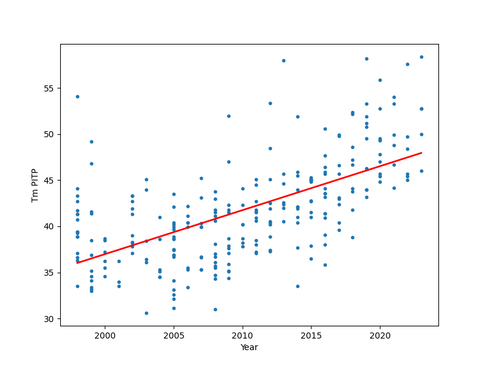A Lost Art? Exploring the NBA's Double-Big Lineups
- Bruin Sports Analytics
- Aug 6, 2023
- 10 min read
By: Nadeev Alam
Introduction
As a Minnesota native, I was devastated on July 1, 2022, when I saw the Utah Jazz were trading Rudy Gobert to the Minnesota Timberwolves. After making the playoffs for the first time since 2018, Timberwolves nonsensically sent away players that were critical to that run and a slew of draft capital to place Gobert, a center that lacks any significant offensive repertoire, next to Karl-Anthony Towns, Minnesota’s star big man that has shined the brightest when he has other offensive talents on the floor alongside him. I did not see how this move would work, and unfortunately, I was proven right. Gobert and Towns only played 27 games together during the regular season, finished eighth in the western conference, lost a game in the play-in tournament, lost in five games in the first round of the 2023 playoffs, and have an uncertain future headed into this offseason. Minnesota’s double big-man experiment, a win-now move, has not bore fruit.
However, this is not the case for all teams with multiple bigs. For example, Tim Duncan entered the NBA during the 1997-1998 season, joining the San Antonio Spurs, led by hall-of-fame center David Robinson. Sports media dubbed them the “twin towers,” and the pairing of centers quickly became a dominant duo on both ends of the court. The big-man duo led the Spurs to championships in 1999 and 2003. Duncan would win three more titles in San Antonio, starting alongside another center each time.
Double bigs may seem to be a lost art in an NBA increasingly focused on wing players and jump shooting. However, two of the four previous NBA champions utilized twin-tower lineups. The Los Angeles Lakers won the 2020 NBA Championship with Anthony Davis sharing the floor with JaVale McGee or Dwight Howard, and the Milwaukee Bucks won the 2021 title by starting Brook Lopez alongside MVP Giannis Antetokounmpo. These lineups create mismatches and provide scoring options while offering rim protection, shot-blocking, and rebounding prowess on defense. However, the wrong combination of big men may create a sluggish offense that lacks spacing and jump shooting and a defense that struggles to guard smaller, quicker lineups on the perimeter.
By studying past lineups, we can gain insights into the factors contributing to their effectiveness, allowing us to understand how they optimized their performance and achieved on-court success.
The Data
For the sake of this article, a “big man” will be defined as a player 6’ 10” or taller with power forward or center listed as one of the positions they play. Teams included in the analysis had two big men in their most-used starting lineup that regular season.
The collected data provides individual statistics of the big men involved, combined statistics of the big men duos (and some trios), and wins in the regular season and playoffs for teams dating back to the 1997-1998 season.
You can view the complete list of teams here, and the metrics in the dataset are defined below.
AST - assists per game
STL - steals per game
BLK - blocks per game
TOV - turnovers per game
ORB - offensive rebounds per game
Stocks - combined steals and blocks
Tot - denotes the total for the team's big men in the specific statistic
Avg - denotes the average for the team's big men in the specific statistic
Tm PITP - points scored in the paint as a team per game
A Style in Decline
Tim Duncan entered a league well-saturated with big men duos, and the lineup style peaked in popularity during his second championship run in 2005. However, there has been a steady decline in the number of twin-tower lineups since 2015, with only five teams utilizing the strategy during the 2022-2023 season. Roster construction in the NBA forms trends based on what wins championships. After the Spurs won two titles in Duncan’s first six years in the league, teams scrambled to find their franchise-defining center pairing. Similarly, since the Golden State Warriors dynasty's success began in the 2014-2015 season, a style focused on guard play, motion offense, and three-point shooting, lineups with multiple big men seem to have gone by the wayside. In fact, the center position itself has taken a significant shift. This year, Nikola Jokic, a uniquely talented center unlike the big men of Duncan’s era, was the first to win Finals MVP at his position since Duncan in 2005.

Furthermore, the big men duos of today look much different from those of the late 90s and early 2000s. The Twin Tower Spurs were characterized by a slow-paced, grind-it-out style of play, prioritizing defensive stops and rebounding. Offensively, they had a dominant presence in the low-post and focused on more “fundamental” basketball. Today, “stretch bigs” or “point forwards,” frontcourt players with a reliable outside shot and the ability to create scoring opportunities for their team, are taking over the league. The last five MVP awards have gone to stretch bigs, and Victor Wembanyama, a 7’ 2” forward with all the skills of a guard, is the most hyped draft prospect since LeBron James entered the league in 2003. Stretch bigs don’t necessarily dominate the interior the way big men of the past did. Instead, they showcase their skills as shooters and creators for their teammates. The graphs below visualize this changing style.
The trends shown in the graphs align with the shifting dynamics of double-big lineups. Since 1998, there has been a steady decline in the steals, blocks, and offensive rebounds of these lineups. This can be attributed to the shift mentioned above towards prioritizing perimeter play and decreasing emphasis on dominating the interior. The data also reveals a steady increase in big men assists and big men assist-to-turnover ratios. This uptick in assists fits the notion that point forwards and stretch bigs are more characteristic of today’s NBA; big men are taking on more active playmaking roles, adapting to the modern game by showcasing their passing and ball-handling skills and involvement in team offense. However, there has been a steep increase in team points in the paint. So, despite a decline in traditional double-big lineups, teams are still finding success by generating offense inside the paint through different means, such as cutting guards and versatile forwards that are key to a motion offense. The increase in paint scoring could also be the result of a faster-paced game and a decline in midrange jumpers. These trends underscore the transformation of NBA basketball towards a faster-paced, perimeter-oriented style, with big men assuming new responsibilities and contributing in different ways to team success.
A Winning Strategy?
With a groundwork laid for the popularity of multiple bigs and the changing style of these lineups, the next step is examining whether utilizing multiple bigs is a winning strategy. As you may expect, there is no simple answer to this question.
The following graphs show the average regular season win percentage of all teams that utilized multiple bigs in their most-used starting lineup that year and the average playoff wins of these teams that made the postseason.

When viewing these graphs, there appears to be…no trend. In the regular season, the effectiveness of multiple bigs peaked in the 2001-2002 season, with these teams logging an average win percentage of 0.59 (48 games) and bottomed out in the 2020-2021 season, with teams only averaging 35 wins this season. But, there has been no steady increase or decrease in regular season or playoff performance since 1998. The results vary with no trend year-to-year.
Interestingly, there is not even any correlation between success in the regular season and the postseason in a given year. For example, 2010 was the worst season for multiple bigs in the regular season but the best for them in the playoffs. One should note that only two out of seven multiple-big teams made the playoffs in 2010, and both made conference finals appearances. However, a similar reverse relationship between regular season and playoff performance can appears in 2001, 2002, and every year from 2020 to the most recent season.
One explanation is that teams employing multiple bigs may face challenges in adapting their style of play to the postseason, where competition intensifies and opponents have more time to make adjustments. The regular season success of these teams might be assisted by the mismatches created by their unique lineup configurations. However, come playoff time, opponents may find ways to exploit their weaknesses or neutralize their strengths.
Additionally, the nature of playoff basketball often highlights the significance of individual shot creation. While teams with multiple bigs may excel in areas like rim protection and interior scoring, they might struggle to generate consistent offense from the perimeter or rely heavily on their guards and wings for shot creation. In the playoffs, where defenses tend to tighten and scoring becomes more difficult, teams heavily dependent on their big men may find it harder to generate efficient offense and compete at the same level as in the regular season.
This negative correlation between winning in the regular season and playoffs could indicate that factors, such as roster construction, that lead to success in the regular season do not directly translate to success in the playoffs.
Metrics that Matter
If there is no correlation between simply using multiple bigs and wins, then one must determine what the winners have in common. Teams that utilize multiple big men are expected to excel in rim protection, rebounding, and interior scoring and may struggle with playmaking and perimeter skills. As such, one would expect a correlation between large block, steal, rebounding, and paint-scoring metrics and the success of teams that utilize multiple big men.
The rest of this article will use the “correlation coefficient” to assess the relationships with winning. The correlation coefficient is a measure that tells us how closely two variables are related. It ranges from -1 to 1, where values closer to 1 indicate a strong positive relationship, values closer to -1 indicate a strong negative relationship, and values close to 0 indicate a weak or no relationship. The following chart shows the correlation coefficients between big men and team statistics from our dataset and their correlation coefficient with regular season and playoff wins.

A look at these results reveals several surprising trends. First, total big men assists has the strongest correlation with wins in both the regular season and playoffs. This shows the importance of a big’s playmaking ability and skills in distributing the basketball to team success. A weaker but still positive correlation exists between a team’s big men’s assist-to-turnover ratios and wins, further emphasizing the significance of efficient offensive decision-making and ball security from big men. So, while the point forward may seem to be a recent phenomenon, teams that utilize multiple bigs have always required their big men to generate offense for the rest of their team.
A similar positive correlation exists between total big men stocks (steals and blocks) and team wins. This relationship underscores the importance of the defensive impact provided by having multiple big men. Contrarily, the weak relationships observed between team points in the paint and total big men offensive rebounds with team wins suggest that these factors have less direct influence on team success. While scoring in the paint and securing offensive rebounds are still valuable aspects of the game, the data implies that other factors, such as playmaking, defensive impact, and efficient decision-making, might have a more significant impact on a team's overall success.
The MVBs
Viewing which big men have had the most significant impact in these systems confirms the previous section’s results. The following chart shows the twenty big men whose presence on a team has the biggest positive correlation with wins in the regular season and playoffs. In short, these are the twenty “Most Valuable Bigs” since 1998.

To no surprise, five-time champion Tim Duncan tops the list. He is immediately followed by Kendrick Perkins, Serge Ibaka, and Kevin Durant, a trio that spent six seasons together playing for the Oklahoma City Thunder. There is a surprise appearance from Vladimir Radmanovic in the top twenty. Radmanovic was integral to the success of the Seattle SuperSonics during the 2004-2005 season as a sixth man and later as a starter for the Los Angeles Lakers in 2008 and 2009.
Radmanovic was one of the NBA’s early stretch bigs, shooting the three ball at 42% during the final year of his career. About half the players in the top 20 can be categorized as either “point” or “stretch” bigs: skilled playmakers and versatile shooters. Duncan, Kevin Durant, Giannis Antetokounmpo, Pau Gasol, and LaMarcus Aldridge would fall into this category. Meanwhile, the rest can be deemed more “traditional” bigs: strong and physical interior players. Kendrick Perkins, Alonzo Mourning, Shaquille O’Neal, and Dwight Howard would fall into this group.
The heavy presence of both "stretch" and "point" bigs among the MVBs reflects the evolving nature of the game and the changing demands placed on frontcourt players. The appearance of stretch bigs like Kevin Durant, Serge Ibaka, and Vladimir Radmanovic highlights the increasing emphasis on floor spacing and the ability to stretch the defense with outside shooting. These players provide an additional scoring threat from the perimeter, opening up driving lanes for guards and creating mismatches for opposing defenses.
Furthermore, the presence of point bigs like Pau Gasol, Kevin Garnett, and Giannis Antetokounmpo demonstrates the value of bigs who possess strong playmaking skills. These players can initiate offense, creating opportunities for their teammates. Their ability to handle the ball and make decisions on the court adds versatility to the team's offensive approach and enables better ball movement and team cohesion.
The combination of stretch and point bigs in the list suggests that successful teams benefitted from a diverse offensive skill set among their big men. This combination allows teams to effectively utilize different offensive strategies, adapt to various defensive schemes, and exploit mismatches against opponents. It showcases the importance of versatility and adaptability in the frontcourt as teams seek big men who can contribute in multiple ways beyond traditional scoring and rebounding roles.
Overall, the presence of stretch and point bigs among the MVBs indicates the evolving nature of basketball strategy and the value of recognizing the unique contributions these players can make.
Conclusion
Analyzing teams utilizing multiple big men reveals the changing landscape of the NBA and the evolving role of big men in basketball. While the popularity of double-big lineups has declined in recent years, the success of particular teams demonstrates the potential benefits of pairing skilled big men.
Looking ahead, the NBA continues to evolve, and new talents like Victor Wembanyama provide glimpses into the game's future. With his impressive skill set and guard-like abilities, Wembanyama represents the ongoing trend of big men who can stretch the floor, create scoring opportunities, and impact the game in multiple ways. As the league continues to embrace versatility and skill in the frontcourt, players like Wembanyama will likely shape the future of double-big lineups and contribute to the ongoing evolution of basketball strategy.
So, while the era of traditional “twin-tower” lineups may be over, the significance of skilled big men and their impact on team success remains evident. The changing dynamics of the NBA, coupled with the continued emergence of versatile centers, suggest that multiple big lineups will continue to evolve and adapt to the demands of the modern game.











